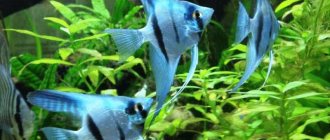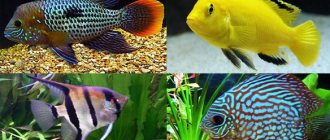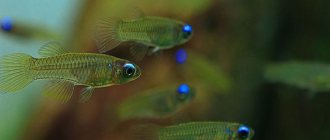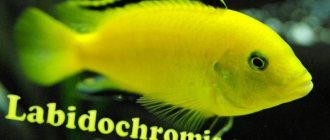Angelfish are considered unpretentious fish in food, but they also have their own preferences. Monotonous and poor-quality food can cause illness and death of fish.
In addition, there are certain rules associated with the frequency of feeding. So, what to feed angelfish in a home aquarium?
Aquarium fish angelfish photo and description
Angelfish are the most common aquarium fish of the cichlid family, which are not only very beautiful, but also have unusual behavior that distinguishes them from others. There are three types of angelfish:
- The common angelfish has a classic body shape of a silvery color with four transverse stripes;
- Angelfish altum or tall-bodied, characterized by an elongated body - some grow up to 30 cm in height;
- Leopold's angelfish is a small species with an aggressive disposition.
- golden green, smoky, striped, black,
- two-color (bicolor);
- tricolor (Koi).
- lace;
- zebra;
- train or veil;
- black;
- gold;
- blue;
- marble;
- Red Devil;
- pearl or diamond;
- chocolate;
- white;
- Pinoy (Pinoy Zebra);
- Dantum Albino.
Aquarium fish Angelfish are not very whimsical, slow and graceful. They are very curious by nature and will watch with interest what is happening in the aquarium. They have a developed intellect and treat their offspring with care. If you walk into a room, they will certainly react to you.
Table of basic parameters of maintenance, care and nutrition:
| What should be the volume of an aquarium for Angelfish? | from 100 liters for a flock from 150 liters |
| What should be the temperature in the aquarium for Angelfish? | from +25-28° C |
| What pH should be in the aquarium? | from 5.5-7.5 pH |
| What should be the hardness of the water in the aquarium? | from 5-15° dH |
| What should be the substrate for an aquarium? | small pebbles or coarse sand suitable for living plantings |
| What kind of lighting should be in the aquarium? | moderate and daylight hours at least 12 hours |
| What should be the movement of water in the aquarium? | moderate |
| Maximum fish size | length up to 15 cm. Height from 26-30 cm (a lot depends on the volume of the aquarium) |
| What does aquarium fish eat? | almost any live food: bloodworms, adult brine shrimp, coretra, tubifex and specialized dry food |
| Type of aquarium fish | peaceful, but small fish and shrimp can become food for them |
| Who is compatible with in an aquarium? | compatible with all peaceful ones that do not fit in the mouth |
| Lifespan of an angelfish | in aquariums they live up to about 10 years, but with proper care up to 20 years |
Minced meat recipe for angelfish
100 gr. Grind beef heart without fat in a blender (meat grinder) or grate it frozen. Grind cabbage, carrots, bell pepper (preferably red), dried nettle leaves (can be bought at the pharmacy). The choice of herbal ingredients can be whatever you have on hand. In volume - the same as the heart. Mix everything, add one raw egg and beat well.
Pour the mixture onto a regular plate and bake in the microwave for 2 minutes. It should be a flat cake. All that remains is to cool it, pack it in a bag and put it in the freezer. If the ingredients have not been ground to a homogeneous mass, then most likely the cake will crumble into pieces. This is exactly what happened to me. The main thing is to make sure that you don’t get too huge pieces. The fish may choke, or there will simply be no one to eat them.
You can add canned green peas and corn as a vegetable component. You can pamper the fish with squid and shrimp. Replace the heart with fish, preferably sea fish. Or buy a “sea cocktail” - a kind of set of shrimp, squid and mussels. All this can become components of minced meat for angelfish. I think that it doesn’t matter what you mix into the minced meat. All these products are good. The main thing is to get the angelfish to appreciate your work and recognize this mess as food! And this will require some persistence.
Large angelfish can be fed with mormysh. In winter I buy live jigs at a fisherman's store. Mormysh can be frozen immediately. But I came up with an even more reliable way to preserve it and disinfect it. I wash the jig in running water, strain through a colander, squeeze it out and put it in the microwave for 2 minutes. Then I stir and turn on the microwave for another 2 minutes. During this time, the jig becomes red - it is almost cooked. Now you can freeze it and give it to the fish as needed. Angelfish eat red mormysh more readily than ordinary raw gray mormysh.
And the last thing: do not feed fish, especially angelfish, with dried daphnia and dried jig! This is not food for aquarium fish! Only livebearers can survive on such food. There is nothing useful in it. Moreover, it is impossible to grow full-fledged healthy fish on it.
If you live in the city, it is not a problem to buy balanced dry food flakes. It is better for villagers to catch their own live food in the summer and freeze it, thus preparing food for the fish for future use almost until the next season. Of course, I don’t catch daphnia or bloodworms myself. In the summer, when it is cheaper, I buy fresh daphnia and cyclops at the market. I stuff it into plastic bags and put it in the freezer. In winter, the same food would have to be bought at a higher price. Why not take care of it during the season?
BREEDING ANKALARIUS IN A COMMON AQUARIUM
COMPATIBILITY OF COCKERS WITH OTHER FISH IN THE AQUARIUM
DISEASES OF MACROPODS: CAUSES AND TREATMENT
HOW TO DISTINGUISH A FEMALE FROM A MALE MACROPOD?
How to care for Angelfish in an aquarium at home
Considering the size of this aquarium fish , to keep it you need to purchase a spacious aquarium - at least 100 liters, but if you keep a flock, then the aquarium should be 150 liters or more. It is necessary that there is enough space for free swimming.
Contents Angelfish cannot be called complex. Considering that these are tropical fish, you need to maintain a water temperature of 25-28° C. Optimal acidity is approximately 5.5-7.5 pH, hardness is 5-15° dH. They live only in aquariums with aeration and filtration. You also need to turn on the compressor twice a day for 20-30 minutes and change the settled water weekly, in a volume of 30%. They like moderate lighting, as they are shy when bright lights are turned on. Thickets of Vallisneria will create an imitation of the natural habitat. Angelfish do not need shelter.
What to feed Angelfish
Angelfish do not require special nutrition. They perfectly consume almost any live food: bloodworms, adult brine shrimp, coretra, tubifex.
It is better to feed angelfish with frozen food, but the food must be brought to room temperature before feeding. Finely chopped ground beef or seafood, specialized dry food, which can be purchased at any pet store, are also suitable.
It is better to feed the fish 2-3 times a day little by little, while making sure that the food is eaten within 1-2 minutes, otherwise overfeeding may occur, which will worsen the health or even contribute to the death of the Angelfish. It is also useful to give your pets “fasting days” once a week - feed them only plant foods.
Features of dry food
Dry fish food contains a set of essential healthy vitamins and macroelements for fish.
The dry product is available in two versions:
- food in granules;
- dry flakes.
When feeding dry food, it is important to take into account the body structure of the angelfish. It is difficult for them to pick up granules from the bottom of the aquarium, so the dry product should be distributed proportionally. If you throw it in large quantities at once, the fish simply will not have time to completely cover it.
Many breeders note that angelfish are more willing to eat food in flakes than in granules. In addition, the flakes pollute the aquarium less, as they do not create water turbidity. If a fish comes across a hard granule, it will hold it in its mouth until it dissolves, resulting in dirty turbidity. And fallen and uneaten granules at the bottom of the aquarium gradually become limp, which significantly spoils the water.
How to distinguish a male Angelfish from a female
It is sometimes difficult to distinguish the sex of a given fish and is only possible when they become sexually mature - at 8-12 months. When buying young animals, you clearly cannot distinguish a male from a female, but the larger ones will probably turn out to be males.
The main distinguishing feature is that males have a fatty bump on their forehead, while female Angelfish do not. Also, in pairs, males are more active, but this is not a clear distinguishing feature, because sometimes females also imitate the behavior of the male.
How do angelfish reproduce?
Angelfish form a monogamous pair and are faithful to their partner. They can spawn directly in the aquarium. When a pair of Angelfish plans to reproduce, they stay together, drive away other fish and clean the place they have chosen for spawning. They spawn every 7-10 weeks. In this case, the female lays several hundred eggs on leaves, pieces of driftwood, and even on the glass of the aquarium, after which the male fertilizes them. Next, larvae appear, which after some time become fry.
In addition to all their advantages, Angelfish are also caring parents who not only look after their eggs, but also the hatched fry.
Peculiarities of angelfish reproduction
In their natural environment, angelfish live in small flocks, so aquarists often keep several representatives of the species at once. Monogamous pairs form within the flock. Fish can spawn quite often - the count lasts for weeks. The better the living conditions, the more eggs there will be in the aquarium.
When the breeding season begins, the couple clears the intended place for “bearing” the offspring. This could be a wide leaf of a plant, a stone, a filter housing, or another surface. The female then lays eggs and the male fertilizes them. The angelfish expresses concern for its offspring - future parents rid the clutch of spoiled eggs and ventilate the water with active movements of their fins.
Photo of angelfish caviar
When the larvae leave the egg shell, they will continue to lead an attached lifestyle for another week. The parents transfer them to another place, where the newly hatched fish continue to consume nutrients from the yolk sac. After this, the fry become active and it is interesting to observe their behavior. After a month they will look like adults.
Within the same aquarium, there may be competition - other males and females eat the eggs. This happens especially often when the fish are already cramped in conditions - the aquarium is cramped, there is little oxygen, there is poor food. To breed angelfish, it is wise to temporarily place the pair in a separate aquarium.
What fish get along with Angelfish in an aquarium?
Common angelfish are peaceful and calm, but due to their large size, it is undesirable to live next to small fish, which can become food for them. Angelfish get along well with a group of barbs, but if one or a couple of barbs are in the neighborhood, the Angelfish will probably have its fins bitten off.
All colorful peace-loving fish will be good neighbors - Gourami, Swordtails, Botia, catfish, Labeo and Tetras, pseudotropheus, Discus, Congo, erythrozonus. You cannot place bettas, Ternetius, Danios, and Guppies in the same aquarium of gold and fighting fish. Angelfish usually make good neighbors with fish of the same species.
Compatibility with other fish
The selection of neighbors for angelfish should be based on the compatibility of several factors:
- preferred environmental conditions;
- aggression of the angelfish towards the species;
- aggression of the species towards the angelfish;
- decorative qualities.
Thus, swordtails, lalius, ancistrus, mollies, gouramis, and guppies are considered ideal neighbors for angelfish. If you wish, you can show your imagination and introduce other species, experiment with combinations of fish. When introducing a new species, you should remember that angelfish can be aggressive towards small fish. Therefore, it is not worth introducing fry into the aquarium - it is better to choose an adult.
Barbs are considered bad neighbors - these generally peaceful fish love to bite off thread-like fins.
What diseases does Angelfish have?
Like any living creature, Angelfish are susceptible to various diseases. If your pet has an inflamed anus, then most likely it is hexamitosis, which means that parasites have settled in the body. It is important to provide timely treatment and place the sick fish separately.
In cases of severe glucose disease, the fish exhibits bilateral bulging eyes and white spots and bumps on the body. The disease usually leads to death. The fish needs to be removed urgently and the aquarium needs to be completely cleaned.
When infected with a rod-shaped bacterium, Angelfish become passive, the ends of the fins and side “fins” rot, a white coating appears on the body - fin rot, and the eyes become cloudy. Immediate treatment is required.
Angelfish are also susceptible to infection with saprolegnia molds. In this case, it is important to start treatment immediately, otherwise, if the fungus penetrates the internal organs, unfortunately, it will not be possible to save the pet.
Feeding recommendations
You can feed the angelfish with any food available to the aquarist. The following options are best:
- Live food: tubifex, brine shrimp, coretra. These lower animals are the most natural type of food for angelfish.
- Artificial feed. This type is convenient for the aquarist: it maintains the balance of nutrients necessary for the normal existence of fish, there are no complex special storage conditions, and the packaging shows consumption rates depending on the number and age of fish.
- Frozen food is an intermediate option. Combines ease of storage and naturalness.
The final choice remains with the owner of the aquarium, however, as with everything, moderation is important here. You can constantly feed your fish with ready-made mixtures, but sometimes it won’t hurt to pamper them with live invertebrates.
A very important point that novice aquarists do not take into account is the gluttony of angelfish. They will never refuse an extra portion of food, and overeating is fraught with serious problems.











